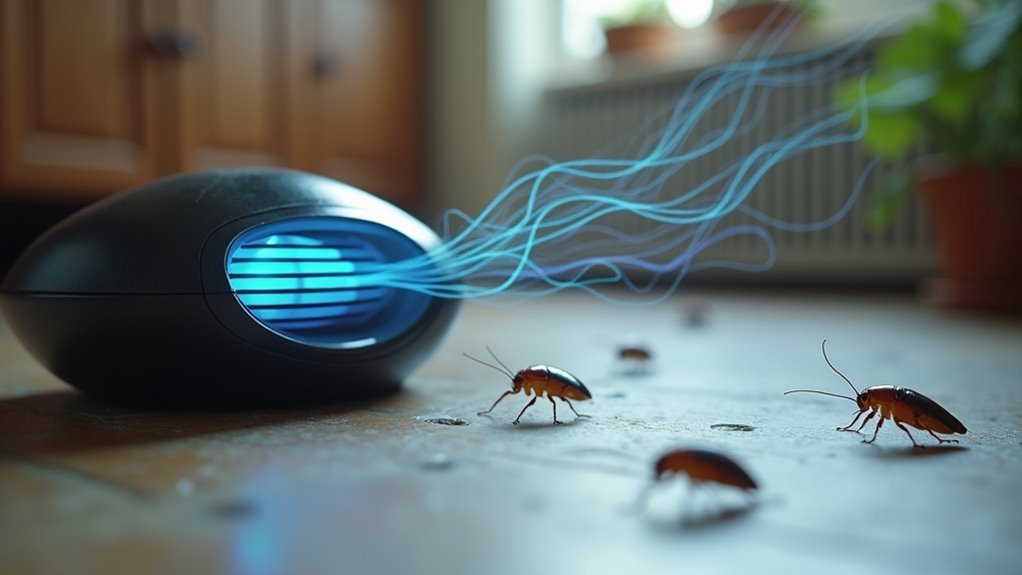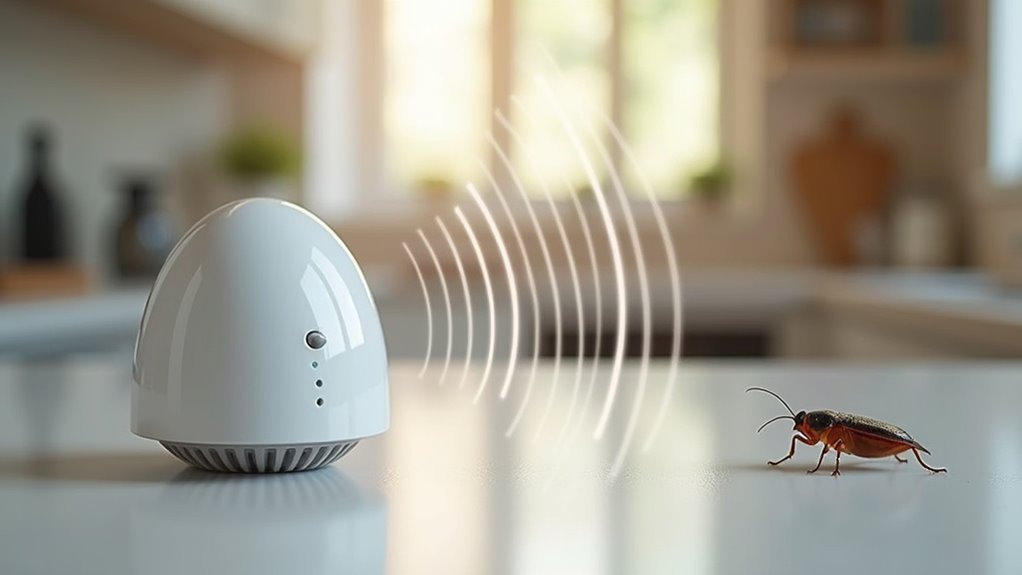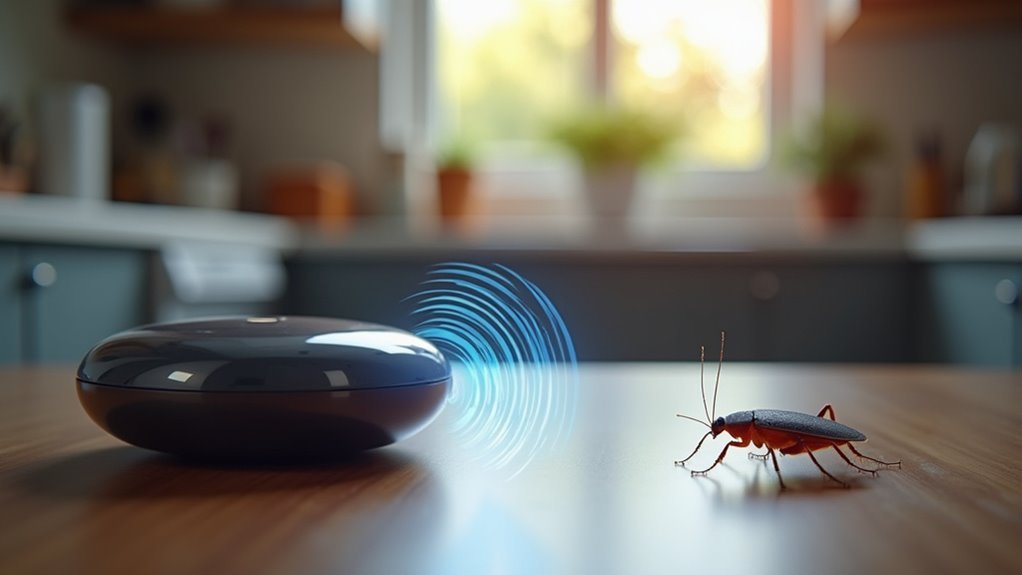Ultrasonic roach repellents work by emitting high-frequency sound waves above 20 kHz that target cockroaches’ specialized sensory structures, though their effectiveness remains scientifically questionable. These devices attempt to disrupt the insects’ nervous systems, creating confusion and disorientation. However, cockroaches primarily detect sounds below 1 kHz and show minimal response to ultrasonic frequencies since their auditory systems evolved for low-frequency detection. For these repellents to have any potential impact, you’ll need continuous 24/7 operation, strategic placement near pest hotspots, and realistic expectations about their limited capabilities.
Understanding High-Frequency Sound Wave Technology

While you can’t hear them, ultrasonic roach repellents emit high-frequency sound waves above 20 kilohertz that target cockroaches’ specialized sensory structures.
These ultrasonic devices operate on the principle that sound waves disrupt pests’ physiological processes, creating confusion and distress that should drive them away from your home.
Ultrasonic frequencies theoretically overwhelm cockroaches’ nervous systems, causing behavioral disruption that forces them to abandon treated areas.
The pest control technology works by plugging into electrical outlets and varying frequency and intensity levels.
However, scientific evidence presents mixed results regarding effectiveness. Research from Kansas State University shows that while cockroaches may exhibit increased movement when exposed to these frequencies, they don’t necessarily flee the area as manufacturers claim.
Additionally, you’ll find that cockroaches can acclimate to the sound over time, potentially reducing the devices’ long-term effectiveness in your pest control strategy.
How Cockroaches Detect Ultrasonic Frequencies
Though cockroaches can’t hear ultrasonic frequencies the way mammals do, they detect these sound waves through specialized sensory hairs called setae scattered across their bodies. These setae function as vibration detectors, picking up sound frequencies up to 1 kHz most effectively.
| Frequency Range | Cockroach Response |
|---|---|
| Low-frequency (under 1 kHz) | Strong detection and response |
| Mid-range (1-20 kHz) | Limited sensitivity |
| Ultrasonic (above 20 kHz) | Minimal response capability |
Kansas State University research revealed that while cockroaches increased movement when exposed to ultrasonic pest repellers, they didn’t demonstrate significant avoidance behavior. Their auditory systems evolved for low-frequency environmental sounds, not high-frequency ultrasonic frequencies. This anatomical limitation explains why many ultrasonic pest repellers struggle to effectively deter cockroaches from infested areas.
The Science Behind Pest Nervous System Disruption

Ultrasonic pest repellents target the nervous systems of insects and rodents by bombarding them with high-frequency sound waves above 20 kHz.
These devices theoretically disrupt cockroaches’ specialized sensory receptors, creating chaos in their neural pathways. You’ll find that pests detect these frequencies through unique sensory hairs that normally help them navigate their environment.
The disruption process creates three main effects:
- Sensory overload – Constant high-frequency bombardment overwhelms their detection systems
- Neural confusion – Mixed signals interfere with normal movement and navigation patterns
- Disorientation response – Pests can’t properly interpret environmental cues
However, research shows cockroaches don’t actually change their behavior markedly when exposed to ultrasonic frequencies.
While increased movement occurs initially, this doesn’t translate to effective repulsion or long-term displacement from treated areas.
Optimal Placement Strategies for Maximum Coverage
Three placement factors determine whether your ultrasonic roach repellent achieves peak coverage throughout your home. First, you’ll need ideal placement near roach hotspots like kitchens, bathrooms, and food sources where these pests congregate. Second, position devices at least 12 inches off the ground to improve ultrasonic frequencies distribution across larger areas.
| Placement Factor | Recommendation | Reason |
|---|---|---|
| Height | 12+ inches off ground | Better sound wave travel |
| Location | Near food sources/drains | Target roach activity zones |
| Clearance | Away from furniture | Prevent sound wave blocking |
Avoid obstructive objects like furniture that block sound waves. For thorough coverage in larger homes, install multiple units to eliminate refuge areas. Check devices regularly to verify they’re functioning properly, as dust accumulation reduces effectiveness.
Frequency Range Requirements for Roach Deterrence

You’ll need to understand that cockroaches detect sounds up to 100 kHz through specialized sensory hairs, which means your ultrasonic repeller must emit frequencies above this threshold to have any potential impact.
Most commercial devices operate between 20-65 kHz, placing them well within cockroaches’ hearing range and making them largely ineffective for deterrence.
Your device’s signal strength also diminishes considerably when sound waves encounter walls, furniture, and other obstacles that absorb or block the frequencies before reaching target areas.
Optimal Sound Wave Frequencies
When manufacturers design ultrasonic roach repellents, they typically program devices to emit sound waves between 20 kHz and 65 kHz—frequencies that sit well above human hearing range but theoretically within cockroaches’ detection capabilities.
However, finding ideal sound wave frequencies proves challenging since no specific frequency has been scientifically validated as effective for deterring these pests.
While ultrasonic pest repellers emit these high-frequency sounds, research reveals significant limitations in their effectiveness against cockroaches:
- Sound wave obstruction: Walls and furniture block ultrasonic frequencies, creating dead zones where roaches remain unaffected.
- Adaptation response: Cockroaches quickly acclimate to repeated ultrasonic exposure, reducing any initial deterrent effects.
- Behavioral confusion: Studies show increased movement rather than actual avoidance or fleeing behavior when exposed to ultrasonic frequencies.
Cockroach Hearing Range Limits
Most ultrasonic roach repellents fail because they’re targeting the wrong frequency range entirely. Your cockroach hearing range only extends from 1 kHz to 10 kHz, while most ultrasonic pest repellers operate above 20 kHz. This creates a fundamental mismatch between what cockroaches can actually detect and what these devices produce.
Their auditory system evolved to process low-frequency sounds for communication and predator detection, not high-frequency sound waves. Even when studies show cockroaches responding to ultrasonic frequencies, they don’t demonstrate the aversion needed for effectiveness.
The sound waves also struggle to penetrate household surfaces, reducing their reach. Without proper anatomical structures to process these high frequencies, cockroaches fundamentally ignore most ultrasonic repellents, making them largely ineffective deterrents.
Signal Penetration Through Obstacles
Beyond the frequency mismatch problem, ultrasonic devices face another significant barrier to effectiveness: their signals can’t penetrate the obstacles filling your home. High-frequency sound waves above 20 kHz diminish rapidly when encountering common household materials, severely limiting their reach to cockroaches hiding behind barriers.
The signal penetration through obstacles presents three major challenges for ultrasonic frequencies targeting cockroaches:
- Furniture absorption – Couches, cabinets, and wooden surfaces absorb ultrasonic waves, creating dead zones where roaches remain unaffected.
- Wall blockage – Solid barriers completely stop these frequencies, leaving entire rooms untreated.
- Limited range – Even without obstacles, ultrasonic signals weaken dramatically over short distances.
This fundamental physics problem explains why these devices can’t deliver consistent effectiveness against cockroaches in real-world environments filled with barriers.
Combining Multiple Devices for Enhanced Effectiveness
Since a single ultrasonic roach repeller may not cover your entire home effectively, deploying multiple devices strategically throughout different rooms creates an extensive barrier against pest intrusion.
When combining multiple devices, you’ll enhance effectiveness by positioning them near pest entry points like doorways, cracks, and areas where roaches typically nest.
You’ll achieve better results using ultrasonic repellers with varying frequencies, as different sound waves target specific pest behaviors.
Don’t rely solely on sonic deterrents—pair them with traditional pest control methods like bait stations and traps for thorough coverage.
Rotate your devices’ locations periodically to prevent roaches from adapting to fixed sound sources.
This movement maintains the deterrent effect and keeps pests guessing about safe zones.
Environmental Factors That Influence Performance
Your ultrasonic repeller’s effectiveness depends heavily on your home’s physical environment, as sound waves can’t penetrate walls or navigate around furniture with the same intensity they emit at the source.
Environmental factors like humidity and temperature affect how cockroaches respond to ultrasonic waves, sometimes making them more focused on survival needs than fleeing from sound.
Your repeller’s performance gets compromised by:
- Cluttered spaces – Furniture, boxes, and household items block ultrasonic waves from reaching target areas
- Competing household noises – Appliances, electronics, and HVAC systems mask the repeller’s frequencies
- Large room layouts – Sound intensity diminishes over distance, creating ineffective zones
Additionally, pest behavior changes as cockroaches acclimate to continuous ultrasonic exposure, reducing long-term effectiveness in your treated areas.
Duration and Consistency Needed for Results
You’ll need to commit to 3-4 weeks of continuous operation before you can accurately assess whether your ultrasonic roach repellent is working.
Don’t expect immediate results during the initial setup period, as roaches require time to respond to the sound waves.
You must maintain consistent, uninterrupted operation throughout this timeline since intermittent use won’t provide the sustained exposure necessary for potential effectiveness.
Initial Setup Time
While ultrasonic roach repellents boast an impressively quick initial setup time that takes just minutes to complete, the reality is that you’ll need patience and consistency to see any potential results.
The device placement process involves simply plugging the unit into an outlet where you’ve spotted roaches most frequently.
However, continuous operation becomes essential for operational effectiveness:
- Power consistency: You’ll watch the device’s indicator light glowing steadily, guaranteeing uninterrupted sound wave emission throughout day and night cycles.
- Strategic positioning: You’ll observe the device maintaining its fixed location, avoiding the temptation to relocate it frequently.
- Patient observation: You’ll notice weeks passing before any changes occur, monitoring roach activity patterns while the device hums quietly.
Regular monitoring and maintenance guarantees sustained performance.
Continuous Operation Requirements
Beyond the simple plug-and-play setup lies a more demanding reality: ultrasonic roach repellents require unwavering 24/7 operation to maintain any potential effectiveness. You can’t simply turn them on occasionally and expect results.
Continuous operation prevents pests from readjusting to their environment. When ultrasonic frequencies stop broadcasting, roaches quickly resume normal behavior patterns, making your efforts worthless.
| Operation Pattern | Pest Acclimation Rate | Effectiveness Level |
|---|---|---|
| 24/7 Continuous | Slower | Potentially Higher |
| Intermittent Use | Rapid | Noticeably Reduced |
| Sporadic Operation | Immediate | Minimal to None |
Physical barriers like walls and furniture already limit sound distribution, so inconsistent power compounds these limitations. You’ll need reliable electrical access and commitment to constant operation, as any interruption allows pests to reclaim treated areas rapidly.
Expected Timeline Results
Even when operating continuously, ultrasonic roach repellents demand weeks of sustained use before you’ll notice any potential behavioral changes in cockroaches.
The expected timeline results vary dramatically among users, with scientific studies showing inconsistent long-term effectiveness despite initial pest behavior modifications.
Your experience with ultrasonic frequencies won’t follow a predictable pattern because:
- Week 1-3: You might observe increased roach movement as they react to the sound waves, creating false hope of effectiveness.
- Week 4-6: Cockroaches typically acclimate to the frequencies, potentially returning to normal activity levels in treated areas.
- Week 7+: Results become unpredictable, with some anecdotal reports claiming success while others experience continued infestations.
Without regulatory oversight, manufacturers can’t provide reliable timelines, leaving you uncertain about when—or if—you’ll see meaningful pest control results.
Limitations of Sound Wave Penetration
Though ultrasonic repellents promise thorough pest control, their sound wave penetration faces significant physical barriers that limit their reach throughout your home.
These ultrasonic frequencies can’t travel through walls effectively and become blocked by furniture, creating dead zones where pests remain undisturbed. The high-frequency waves dissipate quickly in open spaces and get absorbed by carpets, curtains, and other household materials, drastically reducing their effectiveness.
Ultrasonic waves get blocked by furniture and absorbed by household materials, creating pest-safe dead zones throughout your home.
You’ll find that even within the same room, obstacles create shadows where the sound doesn’t reach. This means cockroaches can simply move to areas behind appliances or furniture to avoid the waves.
Additionally, the limitations become more pronounced in multi-room homes where each space requires its own device for any potential coverage.
Measuring Success: What to Expect From Ultrasonic Treatment
While manufacturers tout impressive claims about ultrasonic roach repellents, you’ll likely find the actual results disappointing when measured against real-world expectations.
Consumer reports consistently show mixed results, with many questioning whether ultrasonic pest repellers work effectively for serious pest problems.
When evaluating effectiveness, expect these realistic outcomes:
- Delayed response times – You won’t see immediate changes; some users report waiting weeks before noticing any behavioral shifts in cockroach activity.
- Temporary deterrent effects – Roaches often adapt to the sound to deter pests, eventually ignoring the high-frequency emissions completely.
- Partial coverage issues – Furniture and walls block sound waves, creating “safe zones” where pests continue thriving undisturbed.
You’ll need supplementary pest control methods for meaningful long-term results.
Frequently Asked Questions
Do Ultrasonic Pest Repellers Work on Roaches?
You’ll find ultrasonic pest repellers don’t effectively work on roaches. Studies show cockroaches aren’t markedly repelled by ultrasonic frequencies, despite increased movement. The FTC criticizes these devices for lacking scientific evidence supporting their cockroach control claims.
Is There Any Evidence That Ultrasonic Pest Repellers Work?
You’ll find minimal scientific evidence supporting ultrasonic pest repellers’ effectiveness. Studies from Kansas State University and FTC warnings indicate they don’t work reliably, with pests often acclimating to the sounds over time.
Is There a Sound Frequency That Repels Roaches?
You won’t find a specific sound frequency that effectively repels roaches. While they can hear up to 60 kHz, research shows ultrasonic frequencies don’t create lasting repellent effects, and roaches adapt quickly.
What Are the Disadvantages of Ultrasonic Pest Repellers?
You’ll find ultrasonic pest repellers often don’t work due to lack of scientific evidence, pest adaptation to sounds, limited range blocked by obstacles, and inconsistent results despite manufacturer claims.
In Summary
You’ll find ultrasonic roach repellents work best when you understand their limitations and use them strategically. Place multiple units throughout your home, maintain consistent operation, and don’t expect instant results. While they can’t penetrate walls or eliminate severe infestations alone, they’ll create an uncomfortable environment for roaches when combined with proper sanitation. Remember, success depends on frequency consistency, ideal placement, and realistic expectations about what sound waves can actually achieve.





Leave a Reply